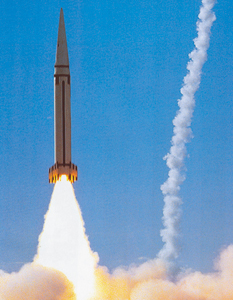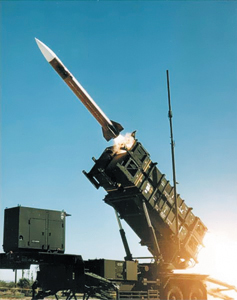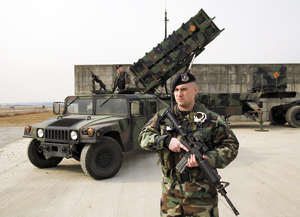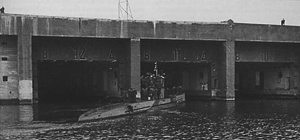For the first time in decades, Air Force aircraft deployed in an international crisis now face substantial risk of damage or destruction on the ground. By some estimates, missile and air attacks could disable up to 70 percent of the aircraft at some overseas bases in the opening minutes of a fight.
The problem is not insurmountable; the Air Force and the Pentagon already have the means to start addressing this critical problem. Even so, there is no doubt the threat is growing.
The affordability, accuracy, and ease of operation of today’s cruise and ballistic missiles make possible an effective surprise attack on theater air bases. Some of the more obvious countermeasures, such as operating from more-distant bases, raise major questions about the ability of current and planned USAF forces to fight an effective and efficient air campaign.
China’s Dongfeng 15 (CSS-6) ballistic missile during a test launch. (

These difficulties are compounded in areas such as the Western Pacific, where the missile and air threat is large, bases are few, and political access to existing facilities often is limited or greatly constrained.
The full magnitude of this challenge can be glimpsed by examining a single, highly realistic scenario—emergency movement of US military forces to the Far East in response to a brewing China-Taiwan confrontation in the year 2015.
In this scenario, one of the main difficulties facing the Air Force would be the shortage of suitable bases in the Western Pacific. Only four of the eight US bases there have hardened aircraft shelters.
Already, three of those four (Osan Air Base and Kunsan Air Base in South Korea and Kadena Air Base in Japan) are well within reach of hundreds of Chinese People’s Liberation Army missiles. Currently, China has fielded about 400 conventional ballistic missiles and 250 cruise missiles that could reach bases in Japan and South Korea. Beijing also boasts a large fleet of advanced fighter-bombers.
The fourth hardened base (Misawa AB, Japan) lies just outside this threat ring. However, that puts Misawa about 1,850 miles from the Taiwan Strait, roughly the same distance from the strait as Andersen AFB, Guam, far to the south.
The US currently operates from only two bases—both on Okinawa—that lie within 500 miles of the strait. Requirements of tanking, sortie rates, and infrastructure availability make Kadena the best theater base for a large fighter contingent.
A typical US crisis response would likely see Kadena receiving a mix of aircraft similar to what was sent to Aviano AB, Italy, for Operation Allied Force in 1999, or to Shaikh Isa AB, Bahrain, for Operation Desert Storm in 1991.
In a crisis, one could find roughly 190 aircraft on the ground at Kadena. Virtually all of these would be parked in the open, as Kadena has only 15 hardened aircraft shelters.
The shelter shortage could be a critical vulnerability if Kadena ever came under attack from a sophisticated enemy—such as China—which has large numbers of advanced, long-range weapons ready at hand.
Consider a Kadena scenario, built around the following realistic assumptions:
- The attacking force finds two categories of targets: (1) stationary aircraft parked in the open, and (2) aircraft that have some measure of protection because they are airborne, taxiing for takeoff, or cocooned in hardened shelters.
- Of the total, nonsheltered parking space, 90 percent is covered by a massive missile attack. No parked aircraft has time to take off. Of this unprotected aircraft force, 75 percent is destroyed. All others are severely damaged.
- Taxiing aircraft escape without damage. Also undamaged, of course, are aircraft that are already airborne.
- Aircraft ensconced in hardened shelters ride out the attack undamaged. However, these bunkered aircraft are stuck on the ground due to massive debris on operating surfaces and more than 2,500 unexploded submunitions. They are targeted in follow-on attacks by cruise missiles.
 |
A US Patriot missile is fired from a mobile launcher. |
Substantial Losses
Losses would be substantial. According to our calculation, only 82 of 268 aircraft deployed to Kadena—31 percent—would be available for postattack operations. These surviving aircraft are assumed to land at other airfields in Japan where specialized parts, maintenance personnel, weapons, etc., are unlikely to be available—further reducing their immediate combat capability.
The threat comes from the PLA 2nd Artillery Corps, which operates China’s land-based strategic missile force—in practice a fourth service co-equal with the Army, Navy, and Air Force.
The 2nd Artillery modernization has special significance for US air and naval forces. As a “missile-centric” service, 2nd Artillery has created the world’s first large, accurate, conventional missile bombardment capability.
The latest DOD report on Chinese military capability observes that, if recent trends continue, the 2nd Artillery by 2015 will have about 500 CSS-6 ballistic and 800 DH-10 cruise missiles capable of reaching airfields in Korea, Japan, or the Philippines.
The speed and accuracy of these systems, combined with the difficulty of defending against them, make the missiles ideal for carrying out rapid, accurate, and intense surprise attacks.
This missile capability is qualitatively different from anything US forces have faced in the past. The Chinese ballistic missiles of greatest significance to US forces operating in the Western Pacific are the CSS-5 and CSS-6. Both are launched from mobile vehicles, have advanced guidance systems, and solid propellant motors. They have longer range, greater ease of operation, and higher reliability than previous-generation missiles such as the liquid-fueled V-2 and Scud.
The CSS-5 and CSS-6 also are accurate and have a range of warhead options that make them more flexible and destructive than earlier missiles. The CSS-6 and similar Russian systems are for sale on the world market.
The attack scenario above assumes each CSS-6 warhead contains 750 1.1-pound bomblets similar to the M74 bomblet carried by the US Army Tactical Missile System (ATACMS).
The bomblets also are dispensed in a manner similar to the ATACMS dispensing sequence, with an assumed average pattern density of one bomblet every 51 feet. This gives each warhead an effective lethal radius against soft targets (such as aircraft parked in the open) of approximately 650 feet.
 |
SrA. Casey Bennett (foreground) and A1C Jacob Sprick guard a US Army Patriot missile air defense artillery battery near Osan AB, South Korea. |
Warding off this kind of threat would be difficult. The key would be dispersal. China could theoretically saturate the entire airfield at Kadena with only 34 warheads. That would hit everything found on Kadena’s parking ramps.
Pentagon officials believe the PLA has about 100 launchers for CSS-6 missiles, so a highly scripted, well-rehearsed surprise attack like this would require fewer than half the available mobile missile launchers. China would still have plenty more for attacks on other targets.
Current Chinese conventional ballistic missiles cannot quite reach Andersen on Guam. However, improved missiles having this capability will likely enter service over the next decade. Assuming aircraft deployed to Andersen during a crisis would be similar to those deployed to European bases and Diego Garcia during Desert Storm, an attack with as few as 17 missiles could produce devastating results.
For more than a decade, PLA planners have assumed that Washington would intervene in any future conflict between Taiwan and China. This assumption is buttressed by the US response to incidents such as the 1996 Taiwan missile crisis, the 2001 EP-3 collision and internment, and the October 2006 surfacing of a PLA Navy submarine near a US aircraft carrier.
Chinese strategists believe a conflict over Taiwan independence would be a “local war” where neither the US nor China would seek to destroy its opponent. The focus would instead end with the political status of Taiwan and the post-conflict political-military situation in the Western Pacific.
Chinese strategists also recognize that it will be decades before the PLA could take on the US in a traditional force-on-force battle and expect to win. Therefore, they focus on strategic principles that would allow China to prevail in a limited conflict with a “technologically superior enemy”—the United States. These principles include:
 |
F-16s of the 80th Fighter Squadron taxi down the runway at Kunsan AB, South Korea. Kunsan is well within the range of Chinese ballistic missiles. |
- Seizing the initiative early in the conflict.
- Achieving surprise by striking at unexpected times and places and/or when the enemy is unprepared.
- Attacking pre-emptively to achieve maximum surprise, psychological shock, disrupt deployments, and increase chances of gaining the initiative.
Chinese planners say initial attacks should feature “key point strikes” against information systems, command centers, key weapon systems, support systems, and bases. These should be conducted with a goal to “paralyze first, annihilate later.”
Initial attacks should be conducted by the best available forces and concentrated in space and time “against targets vital to sustaining and supporting the enemy’s operational system.”
The strategists also seek to raise enemy costs by causing significant military casualties early and “smashing the enemy’s will to resist.”
The PLA has had about a decade to develop operational concepts, acquire systems, and train forces based on these principles. The ballistic missile forces of the 2nd Artillery Corps are especially well-suited for implementing these principles.
The problem isn’t just the missiles. US planners seeking to ensure the availability of air bases overseas must consider that ballistic missile attacks are likely to be combined with (or serve as precursors to) additional attacks by cruise missiles and fixed wing aircraft. Other nations, such as Russia and Iran, have or are working to acquire similar capabilities.
Fortunately, US airpower bases are not mere sitting ducks. Far from it. There are several prudent steps that can be taken or already have been taken to minimize the threat.
Defenses
One response, already implemented, is the deployment of a Patriot anti-missile battalion to Okinawa. With PAC-3 missiles, the latest Patriot systems are much more capable than those deployed during Desert Storm.
However, when presented with dozens of fast, maneuvering CSS-6 re-entry vehicles simultaneously, even the PAC-3 system will likely intercept only a few incoming missiles.
It is probable that any surprise attack would seek to overwhelm the Patriot and also include some missiles aimed at Patriot radar and control systems—to help ensure subsequent missile or aircraft attacks face minimal defenses.
Even if active defenses such as Patriot become much more effective, the large footprint of each “leaking” warhead (well over one million square feet can be covered by dispersed bomblets) means that aircraft must be kept outside missile range, parked inside a shelter, or face a significant risk of destruction on the ground.
Over the short term, USAF will need to use existing systems and facilities in creative ways to negate the growing threat posed by accurate, proliferating missiles.
 |
Two F-22 Raptors move down the ramp at Kadena AB, Japan, in preparation for a mission in the Pacific region. In the background are two F-15s. |
One obvious response is to disperse combat and support aircraft across a larger number of bases—preferably outside the reach of the majority of PLA systems. There are, for example, numerous airfields on the eastern periphery of the Philippine Sea that could be used by USAF aircraft over the short term. The inherent drawback is that safety comes from being outside of Chinese missile range, but this would simultaneously put aircraft farther from the action.
Iwo To (Iwo Jima) is already inside the reach of CSS-5 missiles and therefore is not a good choice as a major deployment base.
Wake Island lies nearly 3,000 miles east of the Taiwan Strait (approximately the distance from Diego Garcia to Baghdad). It is best suited to be a bomber base.
Andersen has long runways and ample parking and fuel storage areas, but is completely unhardened. Washington might be tempted to concentrate a large number of aircraft at Andersen. That would go completely against the logic of dispersal.
Fortunately, there are additional options, in the Mariana Islands. The civil airport on Guam (Won Pat Airport), along with Tinian and Saipan, could host reasonable numbers of fighters and support aircraft.
The remaining three airfields—in the Marianas, Micronesia, and Palau—all offer runways shorter than 7,200 feet, have limited parking space and other infrastructure, and could at best support modest numbers of aircraft. There is also the political issue of gaining permission to use airfields outside US territory.
Dispersal comes with an operational cost. With fighter and attack bases about 1,600 miles from the Taiwan Strait, sortie rates (and thus combat power) would be reduced by 40 percent or more compared to operations from Kadena.
Meanwhile, tanker support requirements would increase enormously—with about three tankers required to support every five fighters deployed. To fly the same number of combat sorties per day as if from Kadena, the US would need to deploy about 100 additional combat aircraft and 200 additional tankers.
Beyond 2020
In the medium term (2015-20), USAF could benefit by making improvements to the airfield infrastructure on the eastern periphery of the Philippine Sea. Extending runways and parking ramps, enhancing fuel storage, and beginning to harden all critical systems would clearly improve the ability of this set of bases to support combat operations under fire.
In the years beyond 2020, more will be required—it is likely that China by then will possess a significant number of missiles with the range to attack unprotected aircraft operating from the periphery of the Philippine Sea. USAF will need to be able to shelter large numbers of aircraft from missile attack and conduct significant rapid runway repair and air base damage repair.
Given the distances involved and limited basing options, it will also be necessary to protect not just fighters, but large support aircraft (tankers, AWACS, Global Hawk, etc.) as well.
 |
A U-boat takes shelter under a bunker at Lorient, France, in World War II. A hardened aircraft shelter of similar size would cost $700 million, but could protect 12 large aircraft or 36 fighters. |
Fighter-size shelters have existed for decades: Cold War-era NATO fighter shelters were three- to six-feet thick and could protect aircraft against submunition attack but not direct hits by penetrating missile warheads.
The accuracy of modern ballistic and cruise missiles would allow an adversary to put two or three missiles on each shelter with high confidence of achieving a hit. With shelters, instead of killing multiple aircraft with each missile, future enemies may have to settle for killing one front-line aircraft with two or three $10 million missiles. It is still a good trade.
Shelters with nine-foot-thick walls and 12-foot-thick roofs constructed of high-strength concrete would be required to defeat ballistic and cruise missiles armed with penetrating warheads. This was done during World War II to protect German U-boats. So shelters suitable for protecting any USAF aircraft could be built, but as always, would come at a price.
Officials estimate the cost of a large, 12-bay shelter at $700 million. This is expensive, but obviously not as expensive as failing to deter a war with China or permanently losing a large portion of USAF combat capability in a surprise attack. Such a shelter could hold wide-bodied aircraft and could protect $10 billion worth of USAF assets from attack.
If the Air Force can protect its aircraft, then an opponent such as the PLA can expect much less benefit from a quick strike. By targeting runways and taxiways, an adversary may be able to disrupt or temporarily halt sorties from a given base. When the attacking missiles run out, the Air Force could repair its bases and bring its full combat power to bear with little or no interference.
The key to success is protecting combat and support aircraft until an opponent’s missile inventory is exhausted. Having more long-range bombers wouldn’t hurt, either.
The Air Force has taken some initial steps toward beefing up its long-range combat capability in the region. International training exercises and bare-bones “lily pad” deployments have become common.
The Air Force may need to fight from a small number of “bunker spaces” in a future Western Pacific war, but steps taken even today to provide access through improved range, dispersal, and hardening can ease the strain.

